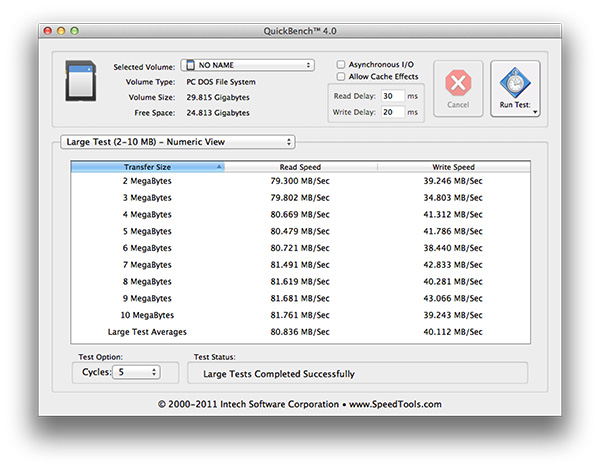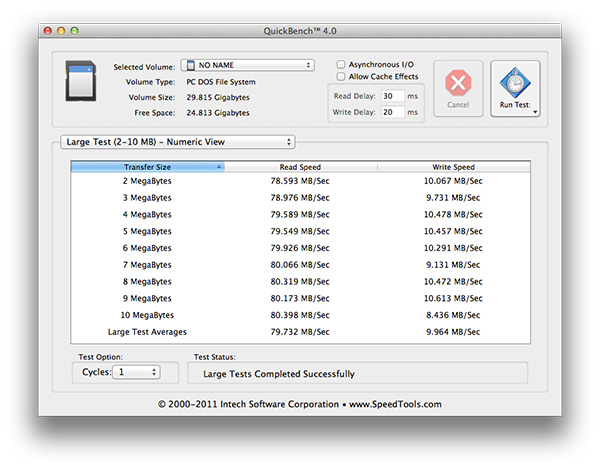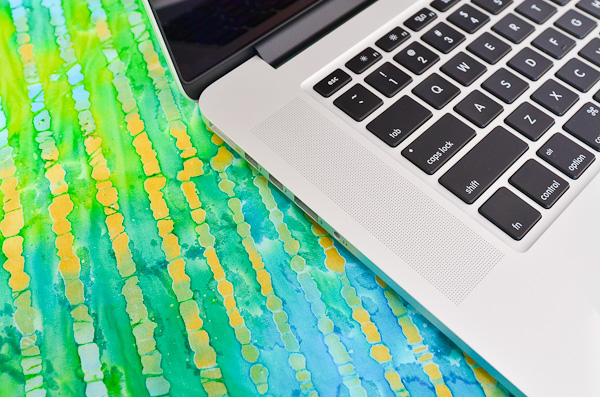The next-gen MacBook Pro with Retina Display Review
by Anand Lal Shimpi on June 23, 2012 4:14 AM EST- Posted in
- Mac
- Apple
- MacBook Pro
- Laptops
- Notebooks
WiFi Performance
The next-gen MacBook Pro is equipped with a decidedly this-gen wireless stack. In other words it uses the same 3x3:3 WiFi solution that was present in the 2011 MacBook Pro and is present in the non-Retina 2012 MacBook Pro as well: Broadcom’s BCM4331. The wireless behavior characteristics are a bit different since this is a physically different chassis, but we’re still dealing with a 3-stream 802.11n solution - not 802.11ac. All three antennas are located in the Retina Display’s housing.
We have seen Apple be conservative with component choices in the past. Deciding to stick with Samsung’s 45nm LP process for the A5X instead of embracing 32nm LP sooner with the 3rd gen iPad is one example that comes to mind. Like a good silicon company Apple appears to mitigate risk in design by sticking with known-good components wherever possible. Major changes to the industrial design are typically paired with comparatively minor silicon changes, and other components are kept as static as possible so long as they don’t overly compromise experience. While 802.11ac dongles and routers are just arriving today, Apple likely froze the Retina MBP’s wireless configuration quite a while ago. Rather than be caught shipping potentially unratified hardware, Apple went the safe route and stuck with 802.11n.

That’s not to say Apple’s wireless implementation is bad. The 15-inch MacBook Pro has been one of the best behaved notebooks on wireless that I’ve had the pleasure of using. The MacBook Pro with Retina Display is no different. Just like before, the best case negotiated physical rate is 450Mbps when paired with a 5GHz 3x3 access point. Unobstructed, within a couple of feet of the AP, I measured as much as 230Mbps to the Retina MacBook Pro. I tested at three different distances from the AP, through walls and on both 2.4GHz and 5GHz bands. Overall performance seemed comparable to the standard 15-inch MacBook Pro, although it’s definitely faster in some areas and slower in others.
| Location 1 | Location 2 | Location 3 | |
| 2011 MacBook Pro (2.4GHz) | 124.0 Mbps | 12.6 Mbps | 61.6 Mbps |
| Retina MacBook Pro (2.4GHz) | 117.9 Mbps | 87.6 Mbps | 44.0 Mbps |
| 2011 MacBook Pro (5GHz) | 186.8 Mbps | 154.6 Mbps | 24.7 Mbps |
| Retina MacBook Pro (5GHz) | 227.7 Mbps | 156.8 Mbps | 33.7 Mbps |
The second test location consistently performed poorly on the 2011 MBP, only on 2.4GHz however. For the most part there were no real surprises otherwise.
The SD Card Reader
It was our own Brian Klug who clued me into the horrible behavior of the 2011 MacBook Pro’s SD card reader. Depending on the SD card used, the integrated SD card reader either performed admirably or was the most frustrating part of the Mac experience. Out of the three SD cards I frequently use: a Patriot LX series card, a Transcend and a new UHS-I Patriot EP Pro, only the Transcend card actually works remotely well with the 2011 chassis. Even then, it’s not perfect. I usually have to insert and remove the card at least once before the reader will recognize it. The LX and EP Pro on the other hand are measurably worse. To get the EP Pro to work in the 2011 MBP’s reader I usually have to push the card in then apply upward or downward force to the exposed edge of the card to get it to read properly. Even then it’ll usually disappear from OS X or be present but read at bytes per second. I doubt this is the fault of the card itself but rather the latest example of incompatibility with the horrible SD card reader in last year’s MacBook Pro.
At least with the cards I’ve tested, the Retina MacBook Pro exhibits none of these issues. Over dozens of insertions I had no issues reading from or writing to all three of these cards, including the problematic ones. I ran a Quick Bench test on the EP Pro as it’s the fastest of the lot and came away with reasonable performance as well. Roughly 80MB/s reads and 40MB/s writes. The numbers are shy of Patriot’s 90/50 spec but quite good.
One of the times I was able to get the EP Pro working in the 2011 MacBook Pro I managed to squeeze in a single Quick Bench run. Read performance was almost identical at 80MB/s, but write performance was far lower at only 10MB/s:
Shortly after the test completed I could no longer write to the drive in the 2011 MBP so I suspect the card reader was acting up again. Needless to say, if you like using SD cards with your MacBook Pro the Retina Display model appears to be much better. That’s not to say there couldn’t be other incompatibilities, but in everything I tested it looks like this problem is finally fixed.
Better Speakers and Dual Mics
Apple is proud of its new speaker design in the Retina MacBook Pro. There’s not a whole lot you can do for tiny laptop speakers but despite shrinking the overall volume of the chassis, Apple has managed to deliver much better sound out of the new speakers in the rMBP. Like most of the upgrades to the next-gen MacBook Pro, you really need to do an A/B comparison to appreciate the difference. And keep your expectations in line with reality, a good set of external speakers are always going to sound better. With that said, the new speakers definitely deliver a fuller, more rich sound than their predecessor. You can still tell you’re listening to some form of integrated speakers, but now they sound distinctly less like they’re coming from a inside a notebook.
In preparation for Mountain Lion's arrival with dictation support, Apple outfitted the next-gen MacBook Pro with dual microphones in order to better focus on your spoken voice and not on background noise. In practice the new mics work reasonably well, rejecting moderate volume background noise. Loud music nearby will still cause interference and as always, accurate dictation requires more than just good quality source audio to get right.













471 Comments
View All Comments
spronkey - Sunday, June 24, 2012 - link
I don't know why people quote this. Who is this "Most People"? The MBP isn't targeted or priced for "Most People".In my personal experience, by far and away the majority of people who own computers end up upgrading *something*, or replacing something out of warranty.
Though, in the lattery category the most common would be replacing a dead HDD, but I don't buy the most people don't upgrade argument. Just look at how large otherworldcomputing is now; and companies like Corsair, Crucial, Kingston wouldn't be producing specific parts for Apple machines if there wasn't a massive upgrade market.
tim851 - Sunday, June 24, 2012 - link
I don't think RAM increases have sped up at all.My major builds over the years:
'96: 8 megs
'98: 16 megs (upgrade)
'99: 128 megs
'01: 512 megs
'03: 1 gig
'06: 2 gig
'08: 4 gig
'12: 8 gig
I don't think most people, including the creative prosumers Apple is targeting, are seeing much use of >4 gigs. 8+ gig configurations have become fairly commonplace recently because RAM has just been ridiculously cheap. I only got the second 4 gig this year because it's been like 30 Euro. Haven't really noticed any of it.
SSDs have taken the pain out of disk swapping too.
Yes, you can cite a lot of anecdotes of people with their multiple virtual machines and huge 4k video projects, but then again Apple has never been trying to satisfy 100% of the market with any product.
felixneo - Sunday, June 24, 2012 - link
maybe not everyone need 8+ GB ram but, for example Adobe Illustrator CS6 recommends 8GB ram on the system requirements page, so i don't know if that qualify as an anecdote, but it sure is the target market for such a laptop. If you don't need more than 4GB ram why you buy a Pro and not an Air? a pissing contest?dtolios - Sunday, June 24, 2012 - link
Its a pissing contest for the VAST (VAST) majority of the MBP buyers, ofc.Vanity is what drives (revenue wise) most high end stuff in Computers, and that is exactly what Apple is about, and made it BIG once they realized who to capitalize on it instead of creativity etc.
Let the romantics and the Jobs is a Saint believers say otherwise.
It's the same in the sports car market (oh, wait, i though all ppl driving around in expensive superfast cars were racing drivers), smartphones (even before the iPhone, but especially after it), the large screen TV, and the clothing industry. It's all a pissing contest, and lucky the few who actually get to distill the innovations to make more innovations out of, thanks to the above contestants paying for things to move forward, even if companies side-step a lot in order to maximize their profits (and not please the crowd, NEVER forget that).
EnerJi - Sunday, June 24, 2012 - link
Screen size, for one. There is no 15" MacBook Air. I'm sure it would sell well if it existed.dagamer34 - Sunday, June 24, 2012 - link
This IS the 15" MacBook Air for all intents and purposes. In fact, that's why I'm almost certain they didn't label the display with the "MacBook Pro" logo. When the other laptops in the lineup get Retina displays, Apple will only be selling "MacBooks". I also expect for the taper to disappear in what we currently call Airs because of the increased battery size needed for the Retina Display. There will also only be one 13" laptop.spronkey - Sunday, June 24, 2012 - link
Actually you just proved my point. In terms of megabytes per year, the trend is close to an exponential increase!Remember - going from 4GB to 8GB is adding more ram in the space of 4 years than you've *ever had in total before*.
We're also starting to see operating systems utilise this more through:
- Caching and prefetch
- Virtualisation
aaand let's not forget what's happening in the browser space - websites are now minature applications with their own requirements on memory.
I'm a software engineer who moonlights as a graphic designer - 4GB isn't enough at all for decent design work - Until I upgraded from 4GB to 8GB early last year, I would often find InDesign and Photoshop eating up all my available memory between them, and 8GB is starting to feel pretty limiting if you want to do a few things with your machine - especially when you start hooking up multiple external displays.
SSDs may take some of the pain out, but things are only going to get worse.
wfolta - Sunday, June 24, 2012 - link
I always use Moore's Law in my plans: a doubling in 18 months. Yes, that's exponential, but when you look at it in terms of "doubling", it's not as crazy as you want to make it out to be.The MBP 17" I was using up until last week had 4GB and that was barely adequate. My rMPB's 16 GB is two doublings, which comes out to 36 months -- 3 years. So in about 3 years, I'll be feeling that 16GB is barely adequate.... except with an SSD I'll actually be a bit better off.
The posting by tim851 shows an increase that's considerably less than doubling every 18 months, which would mean 16 GB would last him even longer than 3 years.
It's a tradeoff: do you want a laptop that's small and light enough to meet Intel's Ultrabook definition, yet it has a screen no laptop can match at any price, a dedicated graphics controller, great battery life, and incredible build quality, with enough RAM that you don't have to worry about upgrading for 3 years or more? Then nothing touches the rMBP.
If you want to trade off several cool feature and slip into the cheapest model machine you can afford, planning on upgrading its components every year or so to keep it acceptable? Then the rMBP's overpriced and inflexible. For you.
spronkey - Monday, June 25, 2012 - link
The point I'm trying to make is that it didn't *have* to be a trade-off. They could have engineered two SODIMM slots in that thing, and a standardised mSATA card. Especially given how much better thermally it is than the previous model...SPLENDEUR - Sunday, June 24, 2012 - link
This was the review I was looking - and waiting - for. It is great that this review goes past the bling factor of the new MBP and goes into the longitudinal nitty gritty.The section regarding Safari performance in this higher resolution, how it jitters during scrolling, was of welcome notice - it has given me a second opinion I needed on whether I should readily buy this (the Retina-populated reviews almost had me!)